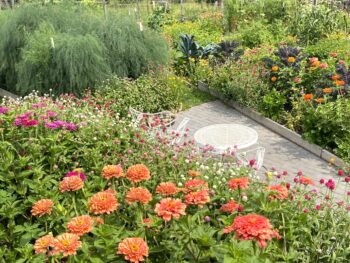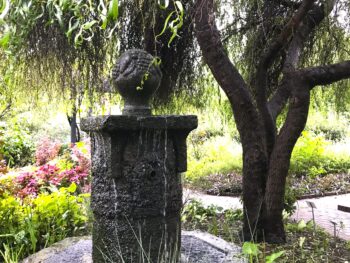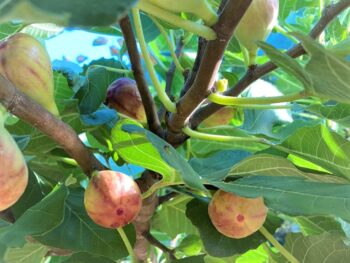Free at last, we are going back to the garden after our Lenten bread journey! And what will be the first plant to greet us, in spring’s rush of sprouting? Dandelions, among the many weeds in the mad dash of growth this time of year. Dandelions are not named specifically in the Bible. However, many scholars consider them among the candidates for “bitter herbs,” being native to the Mediterranean. Since these plants are plentiful in the Promised Land and prominent in most of our gardens, why not dedicate them to the praise of God, and let them draw us to his Word?! Dandelions display three important truths through their horticultural details; may these truths become active in our understanding of God, even as we grumble in trying to remove these weeds from the lawn!
 1. Bitter Leaves.
1. Bitter Leaves.
The bitter-tasting leaves of the dandelion plant recall the bitter suffering the Israelites endured as slaves in Egypt. God delivered his people from ruthless treatment in a dramatic way, to be remembered and celebrated in the Passover meal each spring.
…celebrate the LORD’s Passover, but they are to do it on the fourteenth day of the second month at twilight. They are to eat the lamb, together with unleavened bread and bitter herbs.
Numbers 9:10-11 NIV
By eating bitter herbs, we take in this epic story of deliverance—we “taste and see” for ourselves, and the story becomes part of us. This prepares us for our own bitter experiences, so that then we will know and believe that God is concerned and able to deliver us, too.
for I know that through your prayers and God’s provision of the Spirit of Jesus Christ what has happened to me will turn out for my deliverance
Philippians 1:19 NIV
God hears our cries in bitter situations
 2. Flowers for Bees.
2. Flowers for Bees.
God comforts the Israelites throughout the intense process of being delivered from Egypt with his promise to bring them to a land “flowing with milk and honey.” He pictures their future in a poetic way, relaying that the landscape would have plenty of forage for flocks, enabling herds to multiply and reproduce, resulting in milk to nurse their young. Likewise, the fields would be covered in wild flowers, enabling bees to find plentiful pollen, resulting in honey to feed new bees. Dandelions plant perfectly in the middle of this metaphor, with leaves nutritious for grazers and flowers welcome to pollinators.
They gave Moses this account: We went into the land to which you sent us, and it does flow with milk and honey!
Numbers 13:27 NIV
By speaking of offspring, God reassures the Israelites that not only would they survive their tumultuous break from bondage, but their future was secure, their households blessed to prosper. The story resonates with Joseph’s word spoken as the clan of Israel came to Egypt in the first place:
You meant to do me harm, but God meant it for good — so that it would come about as it is today, with many people’s lives being saved. So don’t be afraid — I will provide for you and your little ones.” In this way he comforted them, speaking kindly to them.
Genesis 50:20-21 CJB
 3. Common.
3. Common.
In a bit of gardener’s license (and admittedly, a stretch of corny comparison), dandelions show us God’s uniting work, for doesn’t every gardener grapple with dandelions? We all have this weedy pest in common! They level the playing field, so to speak; there is hardly a landscape where this prolific plant will not persist. Every garden is equally open to the invasion of dandelions.
Here there is no Gentile or Jew, circumcised or uncircumcised, barbarian, Scythian, slave or free, but Christ is all, and is in all.
Colossians 3:11 NIV
Whether we continue to battle their presence or begin to cultivate their nourishment, dandelions populate every gardener’s chore list and in this, we are united. Embracing God’s uniting work is one of the greatest gifts of the garden: gardening is common ground.
Therefore if you have any encouragement from being united with Christ, if any comfort from his love, if any common sharing in the Spirit, if any tenderness and compassion, then make my joy complete by being like-minded, having the same love, being one in spirit and of one mind.
Philippians 2:1-2 NIV
Find more information about cultivating the dandelion at http://gardenndelight.wpengine.com/plant-guide/dandelion/
For other Bitter Herbs, check back with our Plant Guide as we add more plants
http://gardenndelight.wpengine.com/plant-type/bitter-herbs/
For a more thorough study of Bitter Herbs, see Jo Ann Gardner’s article posted in The Jew & The Carrot
Photo Credits:
©2015 Shelley S. Cramm Dandelion leaves rinsed and ready for sauteeing or soup
©2015 Shelley S. Cramm Detail of the Dandelion’s bitter leaves
©2014 Shelley S. Cramm Bee perched on a pollen-filled dandelion flower
©2014 Shelley S. Cramm Garden dirt is common ground














